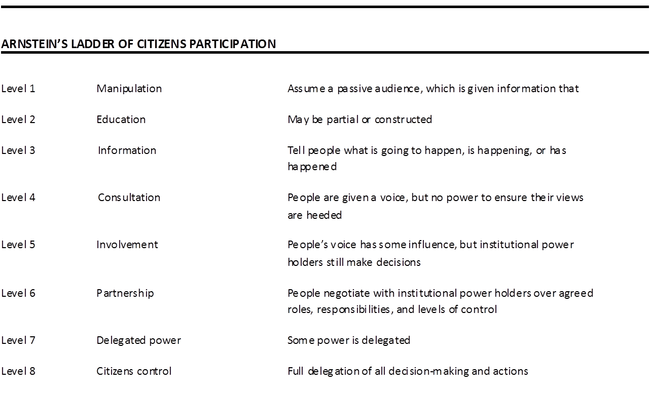PEGASO participation methods
What is Participation?
Public participation is widely recognised as a necessary tool to ensure a successful implementation of environmental policies: the Conference on Environment and Development (Earth Summit) in Rio de Janeiro in 1992, Principle 10 (UNCED, 1992a) and Agenda 21 (UNCED, 1992b) both called for increased public participation in environmental decision-making and led to the adoption in Europe of the Aarhus Convention (UN ECE, 1998). Furthermore participation has become a fundamental pillar of environmental processes as described in the Water Framework Directive (2000/60/EC), the 2002 EU Recommendation on ICZM (2002/413/EC) and the Mediterranean Protocol on ICZM (UNEP-MAP, 2008).
Participation can be defined as a process where individuals, groups and organisations choose to take an active role in making decisions that affect them [1]. Since the Conference on Environment and Development of 1992, public participation has been recognised as a necessary element of all environmental procedures like environmental assessment, local Agenda 21, and ICZM.
The most famous categorization of participation is the so called “Ladder of participation” (Arnstein, 1969 [2]). The categorization shows the different ways in which the organisation responsible for activity (e.g. an authority) can involve participants, in this case citizens.

|
| Fig. 1 : Arnstein’s ladder of citizen participation |
An effective participation process within environmental management brings several opportunities: it allows to obtain information that would not be available otherwise, it minimizes the uprising of conflicts and it leads to a greater quality and durability of decisions [3][4]. Furthermore, participation benefits include widening the representation of interests involved in decision-making, improving local “ownership” of strategies, having a positive impact on the legitimacy of policies and decision-making, ensuring that projects meet citizen’s needs [5].
Notwithstanding, stakeholder participation can also pose challenges. Involving stakeholders can be costly, time-consuming, labour-intensive, confrontational, and can ultimately delay development and implementation of policies. Additionally, if improperly managed, stakeholders participation can create new conflicts or escalate existing ones [6].
Participation for ICZM
Active public participation is an essential requirement of the ICZM process and should have first priority in the planning and in the review of coastal zone management decisions and actions (UNCED, 1992 (a) [7][8][9]). For instance, article 14 of the Protocol on Integrated Coastal Management on the Mediterranean [7] foreseen the appropriate involvement of all stakeholders in the formulation and implementation of coastal and marine strategies, plans, programmes or projects in order to guarantee efficient governance of the ICZM process.
Who is a stakeholder?
As defined by Freeman (1984) [10] a stakeholder is who is affected by the decisions and actions taken by policy makers and who has the power to influence their outcome. Accordingly, understanding who should be involved and on which level within an environmental management process is a complex issue. It is very important to understand how different stakeholders are related to each other and how they are related to the resources to be managed.
The 2008 Protocol on ICZM in the Mediterranean devotes an entire article to the participation specifying who should be included in the participatory process. Article 14 of the Protocol states that:
This Protocol article is meant to be put in practice in the PEGASO project. Participation should be tailored and adapted to the context and objectives of the CASES, and possibly integrated with other tools applied (e.g. indicators, scenarios).
References
- ↑ Reed M. S., Graves A., Dandy N., Posthumus H., Hubacek K., Morris J., Prell C., Quinn C. H., Stringen L. C. (2009). Who’s in and why? A typology of stakeholder analysis methods for natural resource management. In: Journal of Environmental Management 90, 1933–1949
- ↑ Arnstein S. R. (1969). A Ladder of Citizens Participation Journal of the American Institute of Planners 35:216-224)
- ↑ Santos R., Antunes P., Baptista G., Mateus P., Madruga L. (2006). Stakeholder participation in the design of environmental policy mixes. In: Ecological Economics 60, 100–110
- ↑ Reed M. S. (2008). Stakeholder participation for environmental management. A literature review. In: Biological Conservation 141, 2417–2431.
- ↑ Fletcher S. (2003). Stakeholder representation and the democratic basis of coastal partnerships in the UK. In: Marine Policy 27, 229–240
- ↑ NOAA Costal service center (2007). Introduction to stakeholder participation. In: www.csc.noaa.gov
- ↑ 7.0 7.1 UNEP MAP, (2008). ICZM Protocol in the Mediterranean
- ↑ Stojanovic T., Ballinger C., Lalwani C. (2004). Successful integrated coastal management: measuring it with research and contributing to wise practice, Ocean & Coastal Management 47 (2004) 273–298.
- ↑ Edwards, S.D., Jones, P.J.S. and Nowell, D.E. (1997). Participation in coastal zone management initiatives a review and analysis of examples from the UK. Ocean and Coastal Management 36:143–165
- ↑ Freeman R. E., Strategic Management, a stakeholder approach ,1984, Boston, Pitman.